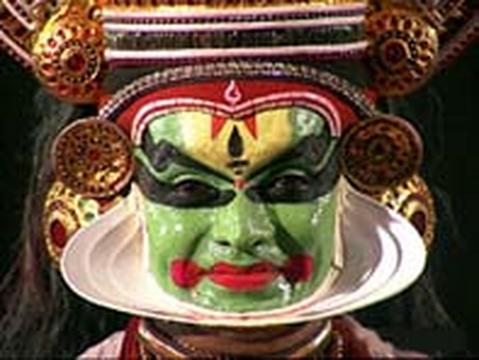 This image was shamlessly stolen from some other place on the Internet so I could show folks what these actors look like; all of my pictures of the performance I saw are on slide film.
This image was shamlessly stolen from some other place on the Internet so I could show folks what these actors look like; all of my pictures of the performance I saw are on slide film.
|
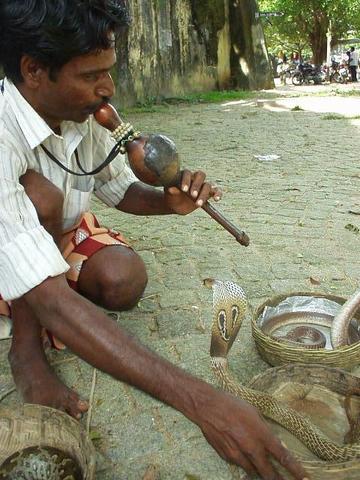 This is the best thirty-five cents I've spent on entertainment in a while. The snake charmer here had three baskets, one with a python (who was sedate and dull) and then two that each with a cobra. He started out by opening the one with a python, and then opened the cobra baskets slightly and tapped them, which elicited a violent hissing.
This is the best thirty-five cents I've spent on entertainment in a while. The snake charmer here had three baskets, one with a python (who was sedate and dull) and then two that each with a cobra. He started out by opening the one with a python, and then opened the cobra baskets slightly and tapped them, which elicited a violent hissing. |
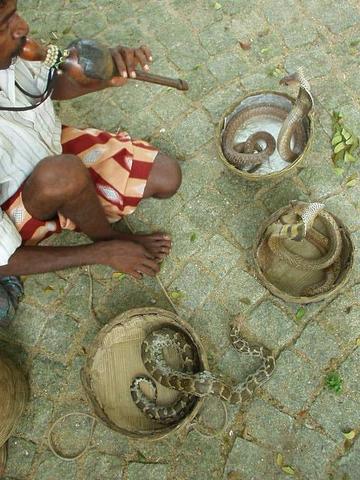 He then played his flute, or Pungi; evidently the cobras follow the motion of the flute and are unable to actually hear it.
He then played his flute, or Pungi; evidently the cobras follow the motion of the flute and are unable to actually hear it. |
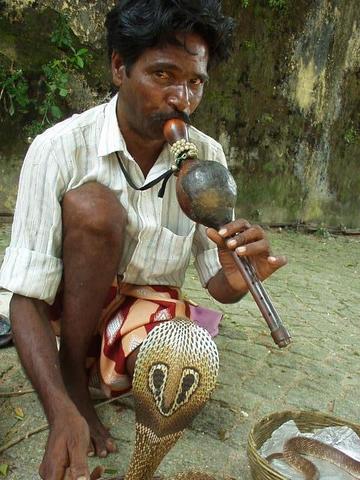 He then moved his hands, or maybe it was just the flute, but the snakes each struck at him a couple of times until, by some signal that I missed -- perhaps it was just that he was putting the lids back on their baskets -- they retreated back in and were silent.
He then moved his hands, or maybe it was just the flute, but the snakes each struck at him a couple of times until, by some signal that I missed -- perhaps it was just that he was putting the lids back on their baskets -- they retreated back in and were silent. |
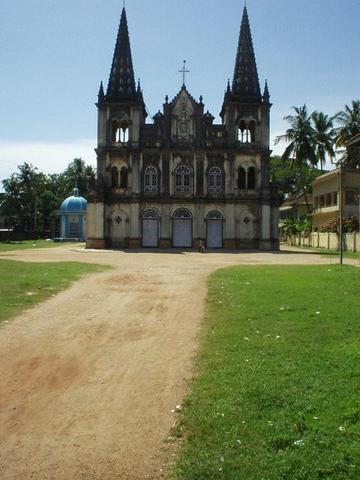 The Santa Cruz Basilica, built in 1902.
The Santa Cruz Basilica, built in 1902. |
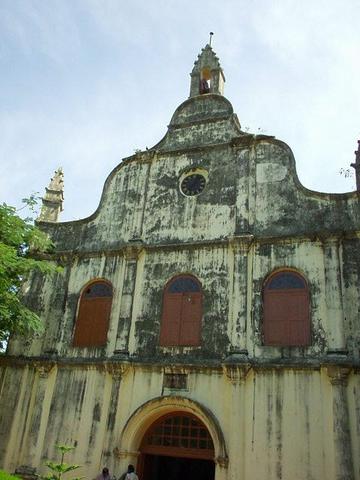 An old church in Fort Cochin, elevated to the status of Cathedral by Pope Paul in 1558.
An old church in Fort Cochin, elevated to the status of Cathedral by Pope Paul in 1558. |
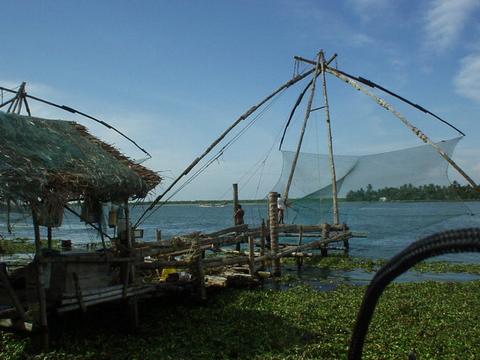 These are set at the northern point of Fort Cochin and are lowered operated mainly at high tide to catch prawns.
These are set at the northern point of Fort Cochin and are lowered operated mainly at high tide to catch prawns. |
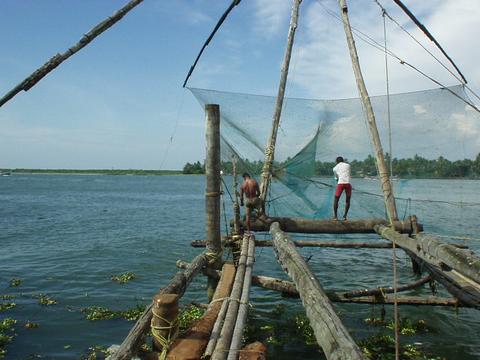 Here two men work on the nets, although I didn't actually see them lower it. The guidebook states that it takes four people to get the net in the water.
Here two men work on the nets, although I didn't actually see them lower it. The guidebook states that it takes four people to get the net in the water. |
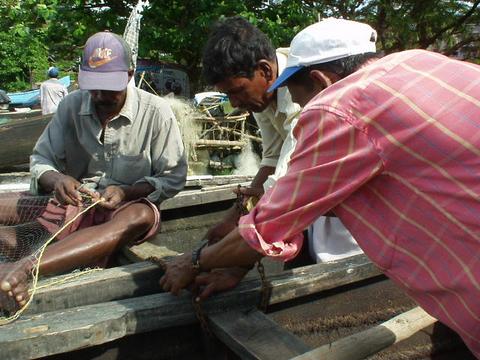 These fellows were working on fixing up their fishing nets. One of the pointed out the different grades of nets, from wide to fine, to catch different types of fish.
These fellows were working on fixing up their fishing nets. One of the pointed out the different grades of nets, from wide to fine, to catch different types of fish. |
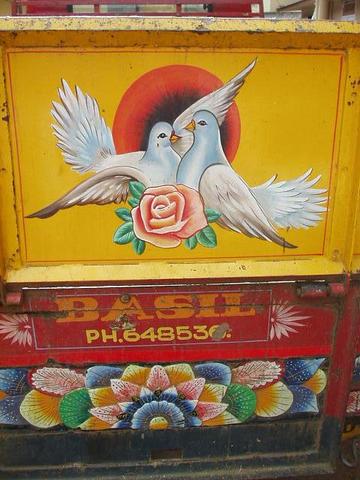 This is a particularly colorful truck in Cochin; where they say "Vishnu" and "Mahlaxmi" in Mumbai, they are "Basil", "St. Thomas", and "Mother Mary" in Portugese-influenced Kerala.
This is a particularly colorful truck in Cochin; where they say "Vishnu" and "Mahlaxmi" in Mumbai, they are "Basil", "St. Thomas", and "Mother Mary" in Portugese-influenced Kerala. |
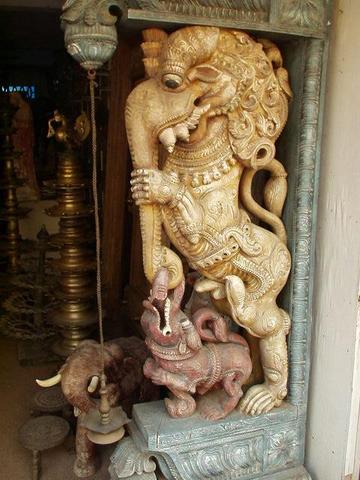 The area near the Jewish Synagogue in Mattancherry, just south of Fort Cochin, is full of shops selling all manner of antiquities, carvings, and jewellery.
The area near the Jewish Synagogue in Mattancherry, just south of Fort Cochin, is full of shops selling all manner of antiquities, carvings, and jewellery. |
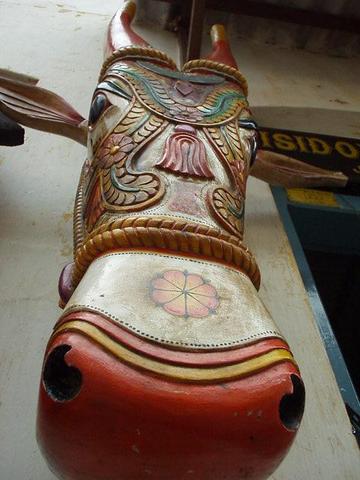 This was hanging in front of one of the Mattancherry shops.
This was hanging in front of one of the Mattancherry shops. |
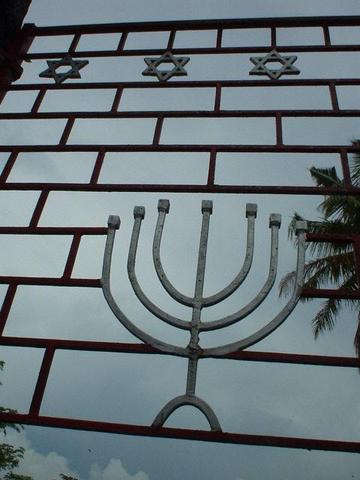 As if the Portugese bringing Christianity, and native Hinduism weren't enough, here in Mattancherry there is also a Jewish Synagogue, founded in the sixteenth century. The history of Jews here on the Malabar Coast extends back to sometime in the first millenium.
As if the Portugese bringing Christianity, and native Hinduism weren't enough, here in Mattancherry there is also a Jewish Synagogue, founded in the sixteenth century. The history of Jews here on the Malabar Coast extends back to sometime in the first millenium.
|
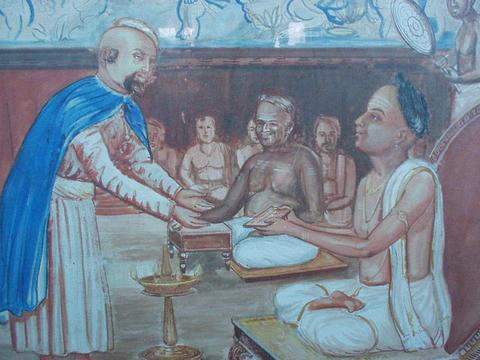 The Jews here, who now number only about twenty, charge two rupees to visit the synagogue. There is a series of paintings inside that illustrate the history of the Jews on the Malabar coast; the caption for this one reads: "The Rajah of Cranganore receives the Jews."
The Jews here, who now number only about twenty, charge two rupees to visit the synagogue. There is a series of paintings inside that illustrate the history of the Jews on the Malabar coast; the caption for this one reads: "The Rajah of Cranganore receives the Jews." |
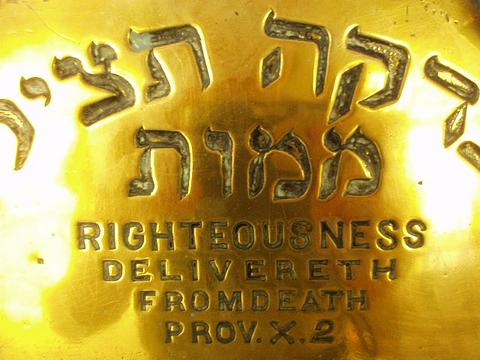 Sign from inside the Mattancherry synagogue.
Sign from inside the Mattancherry synagogue. |
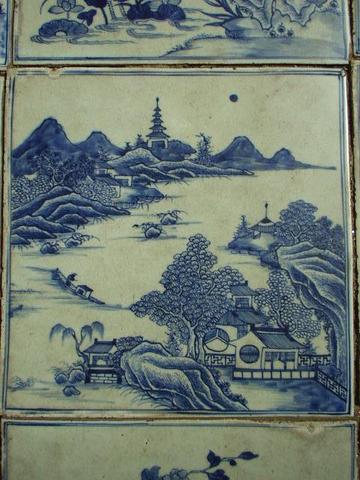 Chinese floor tiles, in a synagogue in India, which were installed upon a donation from a woman living in Mexico.
Chinese floor tiles, in a synagogue in India, which were installed upon a donation from a woman living in Mexico.
|
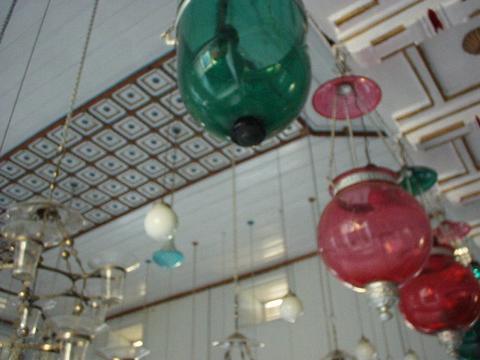 Dozens of these colorful globes depended from the roof of the synagogue.
Dozens of these colorful globes depended from the roof of the synagogue. |
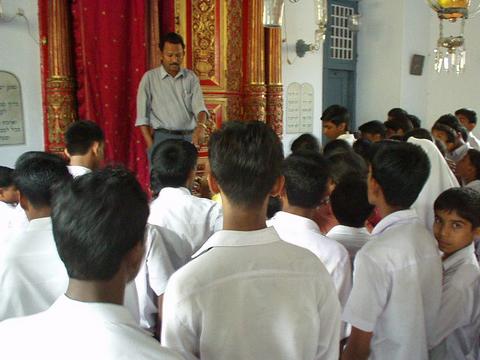 Another improbable sight, a mixture of Hindu and Christian Indians being lectured on Jewish history in the synagogue.
Another improbable sight, a mixture of Hindu and Christian Indians being lectured on Jewish history in the synagogue. |
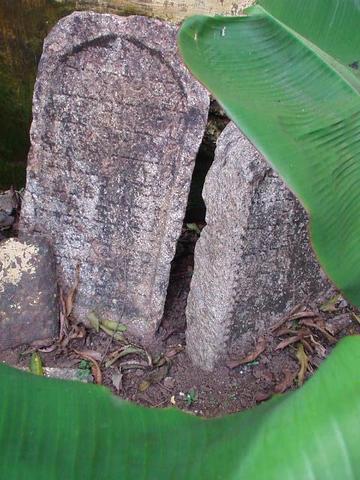 These ancient tombstones attest to the age of the Jewish community here.
These ancient tombstones attest to the age of the Jewish community here. |
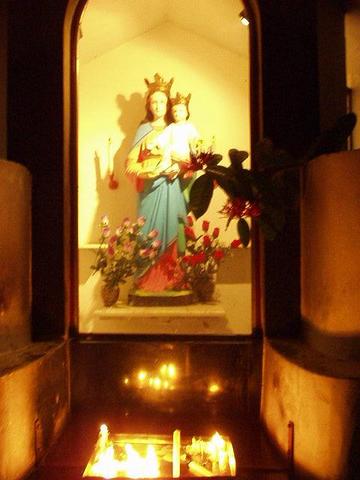 This was two blocks down the street from my hotel; just a small affair in front of someones home, like the Hindu temples on the street in Mumbai.
This was two blocks down the street from my hotel; just a small affair in front of someones home, like the Hindu temples on the street in Mumbai. |
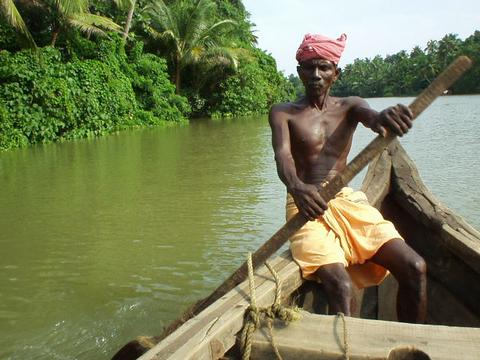 The next day after walking around town, I went for a "backwater cruise", one of the big things to do while in Kerala, along with seeing a Kahtikali theater performance. It seemed a little touristy, but it was well worth it; they took us to a traditional Kerala village, which exist among the freshwater (ten months of the year) canals in Kerala. There was an American couple on the tour, and who were staying in my same hotel, who lived not five miles from where I had recently resided in Oakland. Small world.
The next day after walking around town, I went for a "backwater cruise", one of the big things to do while in Kerala, along with seeing a Kahtikali theater performance. It seemed a little touristy, but it was well worth it; they took us to a traditional Kerala village, which exist among the freshwater (ten months of the year) canals in Kerala. There was an American couple on the tour, and who were staying in my same hotel, who lived not five miles from where I had recently resided in Oakland. Small world. |
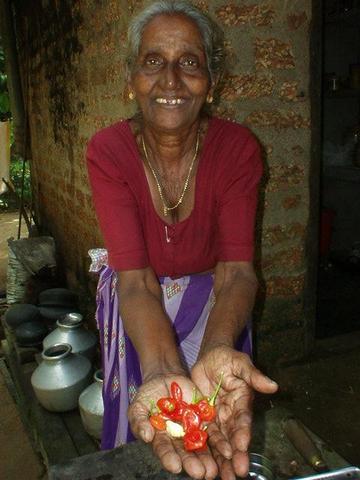 The people in Kerala are literate, the water is safe to drink (according to the Rough Guide India), and the people are very friendly. They voted in the world's first freely elected communist government in 1956. This was one of the women in the village, which seemed to have the entire spice aisle of Safeway, growing in one several-acre plot. These are chili peppers, I didn't catch what variety.
The people in Kerala are literate, the water is safe to drink (according to the Rough Guide India), and the people are very friendly. They voted in the world's first freely elected communist government in 1956. This was one of the women in the village, which seemed to have the entire spice aisle of Safeway, growing in one several-acre plot. These are chili peppers, I didn't catch what variety. |
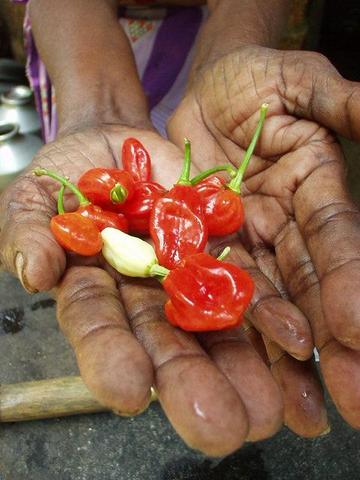
|
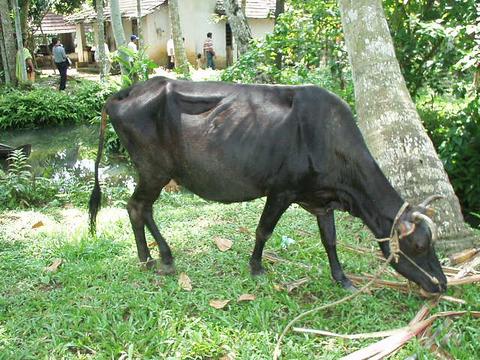 The people of the Keralan backwaters lived on small spits of reclaimed land between the canals, but they still managed to raise chickens, goats, and cows. As our boats went down the canal, everyone looked at us: about half waved in a friendly manner, and the remainer just stopped what they were doing and watched us like we were a roving cultural exhibit.
The people of the Keralan backwaters lived on small spits of reclaimed land between the canals, but they still managed to raise chickens, goats, and cows. As our boats went down the canal, everyone looked at us: about half waved in a friendly manner, and the remainer just stopped what they were doing and watched us like we were a roving cultural exhibit. |
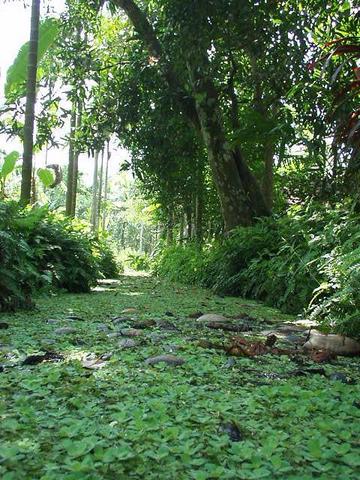 There were wide river like canals for big boats, sometimes with outboards, and tiny little ones like this that were sometimes impassible, since they were choked with water hyacinths. We changed boats twice on the tour for different canal sizes.
There were wide river like canals for big boats, sometimes with outboards, and tiny little ones like this that were sometimes impassible, since they were choked with water hyacinths. We changed boats twice on the tour for different canal sizes. |
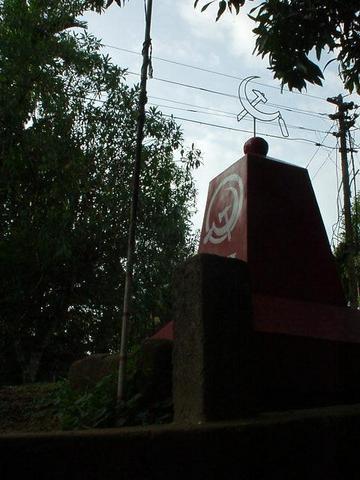 Signs of Kerala's Communist leanings; we saw two or three of these go past, although it was never clear what they were marking.
Signs of Kerala's Communist leanings; we saw two or three of these go past, although it was never clear what they were marking. |
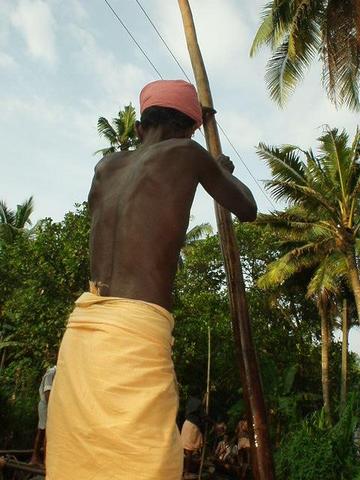 The man who rowed and punted the smaller riverboats worked stoically for several hours; his body was sinewy, with thin but solid muscles. He coughed once, belched once, and wobbled his head when I lifted my camera inquiringly; otherwise, he just rowed and rowed without pause.
The man who rowed and punted the smaller riverboats worked stoically for several hours; his body was sinewy, with thin but solid muscles. He coughed once, belched once, and wobbled his head when I lifted my camera inquiringly; otherwise, he just rowed and rowed without pause. |
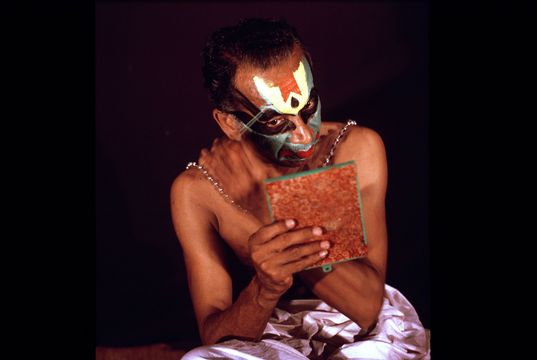 As a kind of pre-show, the dancers in the Kathakali theater come out on stage and put on their makeup.
As a kind of pre-show, the dancers in the Kathakali theater come out on stage and put on their makeup. |
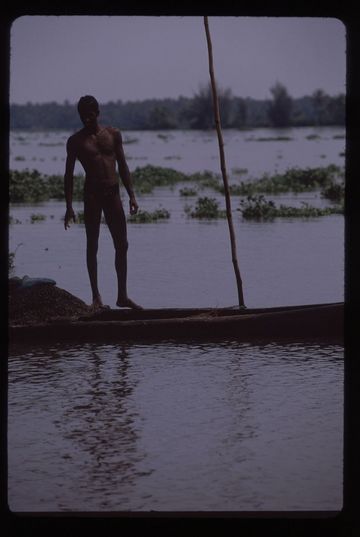 Man standing on his pole-boat at dusk in the backwaters near Fort Cochin, Kerala state.
Man standing on his pole-boat at dusk in the backwaters near Fort Cochin, Kerala state. |
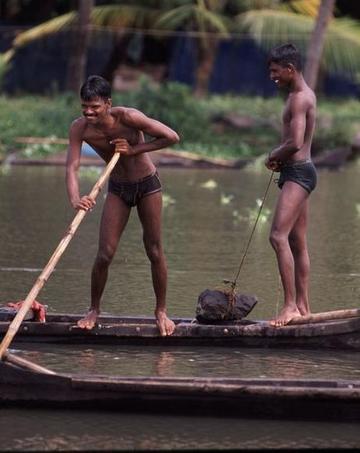 Men poling their boats in the backwaters near Fort Cochin, Kerala state.
Men poling their boats in the backwaters near Fort Cochin, Kerala state. |
 This image was shamlessly stolen from some other place on the Internet so I could show folks what these actors look like; all of my pictures of the performance I saw are on slide film.
This image was shamlessly stolen from some other place on the Internet so I could show folks what these actors look like; all of my pictures of the performance I saw are on slide film.
 This is the best thirty-five cents I've spent on entertainment in a while. The snake charmer here had three baskets, one with a python (who was sedate and dull) and then two that each with a cobra. He started out by opening the one with a python, and then opened the cobra baskets slightly and tapped them, which elicited a violent hissing.
This is the best thirty-five cents I've spent on entertainment in a while. The snake charmer here had three baskets, one with a python (who was sedate and dull) and then two that each with a cobra. He started out by opening the one with a python, and then opened the cobra baskets slightly and tapped them, which elicited a violent hissing. He then played his flute, or Pungi; evidently the cobras follow the motion of the flute and are unable to actually hear it.
He then played his flute, or Pungi; evidently the cobras follow the motion of the flute and are unable to actually hear it. He then moved his hands, or maybe it was just the flute, but the snakes each struck at him a couple of times until, by some signal that I missed -- perhaps it was just that he was putting the lids back on their baskets -- they retreated back in and were silent.
He then moved his hands, or maybe it was just the flute, but the snakes each struck at him a couple of times until, by some signal that I missed -- perhaps it was just that he was putting the lids back on their baskets -- they retreated back in and were silent. The Santa Cruz Basilica, built in 1902.
The Santa Cruz Basilica, built in 1902. An old church in Fort Cochin, elevated to the status of Cathedral by Pope Paul in 1558.
An old church in Fort Cochin, elevated to the status of Cathedral by Pope Paul in 1558. These are set at the northern point of Fort Cochin and are lowered operated mainly at high tide to catch prawns.
These are set at the northern point of Fort Cochin and are lowered operated mainly at high tide to catch prawns. Here two men work on the nets, although I didn't actually see them lower it. The guidebook states that it takes four people to get the net in the water.
Here two men work on the nets, although I didn't actually see them lower it. The guidebook states that it takes four people to get the net in the water. These fellows were working on fixing up their fishing nets. One of the pointed out the different grades of nets, from wide to fine, to catch different types of fish.
These fellows were working on fixing up their fishing nets. One of the pointed out the different grades of nets, from wide to fine, to catch different types of fish. This is a particularly colorful truck in Cochin; where they say "Vishnu" and "Mahlaxmi" in Mumbai, they are "Basil", "St. Thomas", and "Mother Mary" in Portugese-influenced Kerala.
This is a particularly colorful truck in Cochin; where they say "Vishnu" and "Mahlaxmi" in Mumbai, they are "Basil", "St. Thomas", and "Mother Mary" in Portugese-influenced Kerala. The area near the Jewish Synagogue in Mattancherry, just south of Fort Cochin, is full of shops selling all manner of antiquities, carvings, and jewellery.
The area near the Jewish Synagogue in Mattancherry, just south of Fort Cochin, is full of shops selling all manner of antiquities, carvings, and jewellery. This was hanging in front of one of the Mattancherry shops.
This was hanging in front of one of the Mattancherry shops. As if the Portugese bringing Christianity, and native Hinduism weren't enough, here in Mattancherry there is also a Jewish Synagogue, founded in the sixteenth century. The history of Jews here on the Malabar Coast extends back to sometime in the first millenium.
As if the Portugese bringing Christianity, and native Hinduism weren't enough, here in Mattancherry there is also a Jewish Synagogue, founded in the sixteenth century. The history of Jews here on the Malabar Coast extends back to sometime in the first millenium.
 The Jews here, who now number only about twenty, charge two rupees to visit the synagogue. There is a series of paintings inside that illustrate the history of the Jews on the Malabar coast; the caption for this one reads: "The Rajah of Cranganore receives the Jews."
The Jews here, who now number only about twenty, charge two rupees to visit the synagogue. There is a series of paintings inside that illustrate the history of the Jews on the Malabar coast; the caption for this one reads: "The Rajah of Cranganore receives the Jews." Sign from inside the Mattancherry synagogue.
Sign from inside the Mattancherry synagogue. Chinese floor tiles, in a synagogue in India, which were installed upon a donation from a woman living in Mexico.
Chinese floor tiles, in a synagogue in India, which were installed upon a donation from a woman living in Mexico.
 Dozens of these colorful globes depended from the roof of the synagogue.
Dozens of these colorful globes depended from the roof of the synagogue. Another improbable sight, a mixture of Hindu and Christian Indians being lectured on Jewish history in the synagogue.
Another improbable sight, a mixture of Hindu and Christian Indians being lectured on Jewish history in the synagogue. These ancient tombstones attest to the age of the Jewish community here.
These ancient tombstones attest to the age of the Jewish community here. This was two blocks down the street from my hotel; just a small affair in front of someones home, like the Hindu temples on the street in Mumbai.
This was two blocks down the street from my hotel; just a small affair in front of someones home, like the Hindu temples on the street in Mumbai. The next day after walking around town, I went for a "backwater cruise", one of the big things to do while in Kerala, along with seeing a Kahtikali theater performance. It seemed a little touristy, but it was well worth it; they took us to a traditional Kerala village, which exist among the freshwater (ten months of the year) canals in Kerala. There was an American couple on the tour, and who were staying in my same hotel, who lived not five miles from where I had recently resided in Oakland. Small world.
The next day after walking around town, I went for a "backwater cruise", one of the big things to do while in Kerala, along with seeing a Kahtikali theater performance. It seemed a little touristy, but it was well worth it; they took us to a traditional Kerala village, which exist among the freshwater (ten months of the year) canals in Kerala. There was an American couple on the tour, and who were staying in my same hotel, who lived not five miles from where I had recently resided in Oakland. Small world. The people in Kerala are literate, the water is safe to drink (according to the Rough Guide India), and the people are very friendly. They voted in the world's first freely elected communist government in 1956. This was one of the women in the village, which seemed to have the entire spice aisle of Safeway, growing in one several-acre plot. These are chili peppers, I didn't catch what variety.
The people in Kerala are literate, the water is safe to drink (according to the Rough Guide India), and the people are very friendly. They voted in the world's first freely elected communist government in 1956. This was one of the women in the village, which seemed to have the entire spice aisle of Safeway, growing in one several-acre plot. These are chili peppers, I didn't catch what variety.
 The people of the Keralan backwaters lived on small spits of reclaimed land between the canals, but they still managed to raise chickens, goats, and cows. As our boats went down the canal, everyone looked at us: about half waved in a friendly manner, and the remainer just stopped what they were doing and watched us like we were a roving cultural exhibit.
The people of the Keralan backwaters lived on small spits of reclaimed land between the canals, but they still managed to raise chickens, goats, and cows. As our boats went down the canal, everyone looked at us: about half waved in a friendly manner, and the remainer just stopped what they were doing and watched us like we were a roving cultural exhibit. There were wide river like canals for big boats, sometimes with outboards, and tiny little ones like this that were sometimes impassible, since they were choked with water hyacinths. We changed boats twice on the tour for different canal sizes.
There were wide river like canals for big boats, sometimes with outboards, and tiny little ones like this that were sometimes impassible, since they were choked with water hyacinths. We changed boats twice on the tour for different canal sizes. Signs of Kerala's Communist leanings; we saw two or three of these go past, although it was never clear what they were marking.
Signs of Kerala's Communist leanings; we saw two or three of these go past, although it was never clear what they were marking. The man who rowed and punted the smaller riverboats worked stoically for several hours; his body was sinewy, with thin but solid muscles. He coughed once, belched once, and wobbled his head when I lifted my camera inquiringly; otherwise, he just rowed and rowed without pause.
The man who rowed and punted the smaller riverboats worked stoically for several hours; his body was sinewy, with thin but solid muscles. He coughed once, belched once, and wobbled his head when I lifted my camera inquiringly; otherwise, he just rowed and rowed without pause. As a kind of pre-show, the dancers in the Kathakali theater come out on stage and put on their makeup.
As a kind of pre-show, the dancers in the Kathakali theater come out on stage and put on their makeup. Man standing on his pole-boat at dusk in the backwaters near Fort Cochin, Kerala state.
Man standing on his pole-boat at dusk in the backwaters near Fort Cochin, Kerala state. Men poling their boats in the backwaters near Fort Cochin, Kerala state.
Men poling their boats in the backwaters near Fort Cochin, Kerala state.